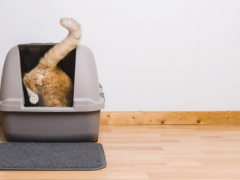It happened.
The good news about the new job, the new house we have been waiting for. We are ecstatic!
But with a glance towards our beloved cat, our excitement suddenly becomes overshadowed by guilt and confusion. What about my cats?
Too many animal shelters everywhere get swamped almost daily with the request to find left behind pets a new home. People are convinced that cats are aversive to change. But I can assure you that an abandoned suffers just like you would.
Before you start finding a new home, let’s have a look whether there might be a way around your problem, which could allow you to keep your cat.
Below I listed some feasible solutions to some of the most common reasons for rehoming a cat, which may help you consider and live happily ever after with your feline.
Allergies

It is upsetting when one of your family members suddenly becomes allergic to your cat. Many assume that the only solution here is re-homing.
But there are things you can do before actually giving your cat away.
Perhaps it is not even the cat who caused the allergy but the cat litter. There are different kinds of litters out there and changing to a dust free one could help your allergy.
One can find lots of information online around cats and allergies which shows that choosing the right cat litter may reduce or even alleviate the symptoms entirely.
Of course it is helpful to keep your cat up to date with her vaccinations, and to make sure it is regularly de-flea’d and de-wormed. Grooming your cat outside instead of inside has proven to work wonders too.
Hoovering frequently, washing the cat’s bedding regularly and changing from carpets to hard wood floors are some other ways of helping your allergy as well.
And of course the World Wide Web is filled with an abundance of useful information.
Rented Accommodation: No Pets Allowed
Another common reason for re-homing a cat is moving into a house or apartment with a clear ‘NO PETS ALLOWED’ clause in the lease.
Let me tell you that this rule is often put there for the “worst case scenario” in which pets are making a mess or damage furniture. In my experience, you can often talk to landlords, especially if you explain to them that cats are incredibly clean animals, and show them your latest ‘state of the art’ scratching tree.
Why scrape at furniture when there are seven mice, three furry balls and a fluffy heart dangling off your eight layers cat tree? All this while the top royal cushion is directing towards the window with amazing view?
You can also provide references from your last landlord, which will reassure the owner that there is no need to worry. Maybe even invite him/her after having moved in for a cup of coffee, and make your friendliest and most affectionate cat rub herself on her leg or even cuddle up to her.
Lease signed!
Emigrating Abroad

According to Outside Living Today, If you are planning to emigrate, there is also a way to take your cat with you.
Considering that your cat is not elderly or has a medical condition and the journey may be too much for it. In this case, re-homing would be the best option to avoid too much stress for your cat. But if it is in good health, there is no reason why not to bring your cat along with you.
There are websites with plenty of tips how to emigrate with your cat and they will be happy to advise you about your adventure.
I once had a friend, an even more “crazy cat lady” than me (yes that’s possible!) who lived in Ireland with her 8 cats. They always seemed to find her, the word spread fast, she was the place to go. But at one stage she decided to return to her home country Australia.
So she enquired at her local vet about the necessary import requirements and paperwork, carried out all the needed procedures and off they went.
The last thing I heard is that she now continues her “crazy cat lady” life overseas and even got new additions. But that’s another story. There are also companies you can hire to organise everything for you.
So no reason to deprive your cat of a nice Australian suntan.
Pregnancy

There is an assumption that the risk of getting sick in pregnancy is extremely high with a cat around. But it is proven today that it is more a ‘tale’ than a medical reality. The chance to get seriously ill through your cat is very low.
If you are still concerned for your health during pregnancy, there are a few things you can do to prevent the risks you might be worried about.
Wearing gloves when cleaning the litter tray or asking another family member to do the litter duty for you is one. Having your cat up to date with the latest vaccinations and making sure it is de-wormed and de-flead is another one.
Then there is no need to re-home your cat, the opposite. Cats are highly intuitive and there were cases where cats tried to warm and take care of the pregnant belly by lying on it or snuggling up to it. A free heating blanket with a calming purr, what else do you need?
New Baby In The Home
The arrival of a new baby is another common reason for people re-homing their cat. No need for that at all.
Indeed, having a dog or cat in the home can have immense benefit to the development of babies and small children, allowing them to form a bond with animals from early on. Learning to respect and take care of animals is quite possibly laying the foundation for a lifelong love for animals.
Clinical studies have also shown that living with pets can build up their antibodies leading to a reduced risk of asthma and allergies.
Just make sure to take a few simple precautions like closing the nursery door when the baby is on its own, keeping the litter tray out of reach when the baby starts moving around and changing the litter frequently.
Use rubber gloves when cleaning the tray and always wash your hands. Also make sure the vaccinations are up to date and the cat is regularly de-wormed and de-flead. Then there is nothing which keeps your cat and your baby from being lifelong Bffs!
Behavioural Problems
Behavioural problems can make people feel helpless and frustrated leading them often to think re-homing as only solution.
But there is help out there!
Usually your local vet will be happy to advise you about the problems your cat is showing.
But obviously sometimes it is the best thing to re-home your cat if you see that with all the support the behaviour doesn’t improve.
FELIX was a cat we adopted a while ago from a lady who needed to re-home him due to personal reasons. He was one gorgeous black and white cat, and the lady told us that he was very playful and loved other cats and humans. But as soon as he arrived at our home he seemed extremely stressed. Even when my other cats were friendly with him, he showed signs of deep stress.
Inappropriate toileting, spraying, refusing to eat and hiding in the darkest corner. We gave him quite a bit of time as it is not unusual for some cats to be more sensitive than others and to need more time and extra TLC.
It turned out that FELIX and his former owner had a very close bond and he had chosen her as her favorite human. Consulting my vet he confirmed that FELIX was missing her terribly.
So together we decided to “re-home him back” to his former owner, who admitted that she felt it was a big mistake to give him away. Last we heard was that he was back to his playful character, and most importantly back to his food.
It shows that it is important to think careful about re-homing a cat as it not only upsetting us but stresses out the poor cat as well.
But if you have come to the well reflected conclusion that there is no other way, there are a few things to consider to make the transition as smooth as possible, and guarantee a happy second chance for your cat.
Do Never Advertise Your Cat As ‘free To A Good Home’!
I strongly advise against advertising your pet as ‘Free to a good Home’ as the widespread activity like using cats and kittens as ‘bait’ in dog fighting or at Halloween for cruel so called ‘halloween traditions’ is well alive.
When a few years back my cat Momo had kittens I invited every single person to my home so I was able to get an impression of the home they would go to. One day a lady arrived and told me stories of cats she had before and when she mentioned that one cat had problems and she put it down I can assure you she didn’t stay long.
I chose relying on my gut feeling which never goes off, with animals especially. I also made sure I received updates/photos of my kittens so I was sure I had made the right choice for a loving home.
Privately
Re-homing your cat via friends, family or colleagues is also a good option. Firstly you trust them and if they are not able to take your cat themselves, they may know someone they trust and would consider adopting your cat.
Officially
Of course a rescue shelter is the best choice most of the time. If you don’t have a shelter close to you, I am sure you will find one online or on social media. In my area we have the Animal Help Net Kerry, which connects with every other rescue volunteer or shelter. They do fantastic work around lost, stolen and re-homing pets. They get all the necessary details from you, share the it everywhere on social media and make sure to find a suitable home for the animal.
Just some last points to consider:
- Re-homing through a rescue organisation or shelter is the most professional way to re-home your cat. Make sure it is a NON KILL shelter!
- If you decide to do the re-homing privately yourself, meet the people face to face. Maybe invite them to your home and get an impression of the person and see how they interact with your cat. Don’t be afraid to ask many many questions.
- NEVER re-home your cat or kitten before checking the person and their circumstances, as there is the danger of your cat being used as ‘bait’ or in other illegal practices.
- Ask the owner to give you updates / photos during the first year of re-homing. If they refuse, be concerned!
- If the new home is quite close, advise the new owner of the need to keep the cat indoors for at least 3-4 weeks to get to know their new territory well and prevent them from straying back home.
Cats are part of our family and once again, I strongly advise to always weigh multiple options before pursuing the final step to give your cat away.
Please deliberate well and just know that there is help out there for a purrfect happily ever after.
About The Author

by Christine Klein
Author with Purrfect Cat Tales
www.thebarefootbutterfly.com












Hey, thats a great article I would love to share the link to your article on my site.
Regards
Petskeeping.com